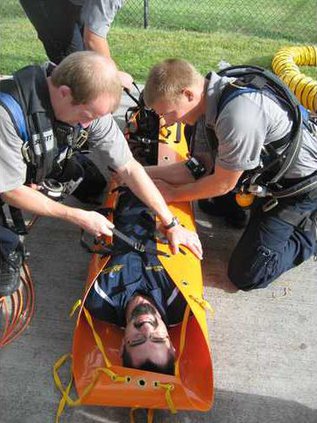The swimmers are gone and the water has been drained from Great Bend’s Wetlands Aquatic Facility, so firefighters took the opportunity Wednesday to do some confined-space training at the city water park.
Capt. Luke McCormick said all three shifts of firefighters have now received this specialized training in rescue work under extreme conditions. If necessary, he said, they could pull a victim to safety through an opening as small as 14 inches in diameter.
Barton County has provided funds for a Technical Rescue Trailer with a variety of equipment that could come into use after a natural or man-made disaster such as a building collapse or someone trapped in an oilfield tank. Firefighters can cut a trench through hardened concrete or use a tripod, winch and ropes to rescue someone from a cave or other confined area.
There are two types of rescue stretchers. “The Sked stretcher allows us to wrap a victim up, like a cocoon,” McCormick said. The LSB, or long spine board, is similar but provides more rigid support for cases of suspected spinal injuries. Both are needed for technical rescues involving confined spaces or high angles.
This was the first time firefighters have used the municipal pool for the training, McCormick said. “They’ve got an underground cavern where water recirculates in the water park features.” Access to the underground area is through a trapdoor under one of the shelter umbrellas. For firefighters, it simulated a manhole.
There are also protective suits, breathing gear and air monitors. Firefighter Tony Lees said the training included sampling the air for the level of four gasses: hydrogen sulfide (H2S), carbon monoxide (CO), oxygen (02), and the lower explosive level (LEL) of flammable gasses.
“The area for working on a patient is small,” Leeds said of confined-space training. The firefighter may have an air line, rope and communication line attached to him, and can’t get tangled up.
In the future, McCormick said, the Great Bend Fire Department hopes to build its own underground training area, or prop room, that is even more realistic for advanced training at any time of the year. Fire Station No. 2 already has a tower where firefighters can practice moving through a smoke-filled prop room.
Firefighters conduct confined-space training





